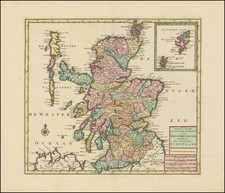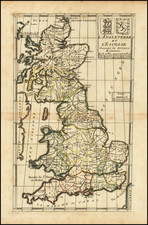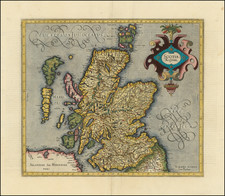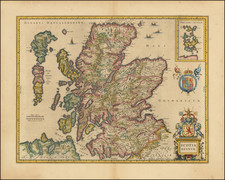Beautifully colored Scottish map of the northern part of the British Isles from the early part of the 19th century.
This map shows Scotland in detail, with county boundaries showing the extent of the populated Lowlands and less populated Highlands. Geographic detail is nicely laid out. The many islands of Scotland are shown, including Isla, Arran, Skye, and the Outer Hebrides.
This map was published as part of Ewing's General Atlas by Oliver and Boyd, and engraved by W. & D. Lizards.
The Lizars were a Scottish family of engravers and printers who produced many views and maps. Daniel Lizars Sr. (1754-1812) was the son of a shoemaker, but he apprenticed with Andrew Bell, a printer and engraver. Lizars set up his own printworks near St. Giles Cathedral and took on his own apprentices, including George Bartholomew, whose son John would go on to found the important mapmaking firm later know as John Bartholomew & Son Ltd.
Daniel Sr. had three sons: Daniel Jr., John, and William Home. He also had a daughter, Jane Home. Daniel Jr. (1793-1875), the youngest of the boys, apprenticed in his father’s shop alongside George Bartholomew. When his father died in 1812, Daniel Jr. took over much of the business, expanding it and specializing in maps. The company went bankrupt in 1832, however, and Daniel emigrated to Canada.
John Lizars (1792-1860), the middle son, studied medicine and became Professor of Surgery at the Royal College of Surgeons of Edinburgh, as well as senior surgeon at the Royal Infirmary of Edinburgh.
William Home Lizars (1788-1859), the eldest, also apprenticed in his father’s shop. After learning engraving, William entered the Trustees’ Academy to learn under John Graham. He was a skilled painter and artist. When his father died, and after his Daniel Jr. left, he carried on printing and invented a method of etching that looks like wood engraving.











![[Scotland] L'Ecosse dela le Tay, divisee en toutes ses Provinces: tiree des Cartes particulieres de Timot Pont, de R. Gordon a Straloch &c. . . . .1665](https://storage.googleapis.com/raremaps/img/small/91091.jpg)
![[ Scotland ] L'Escosse Royaume en ses deux Princpales Parties . . . 1665](https://storage.googleapis.com/raremaps/img/small/102859.jpg)

